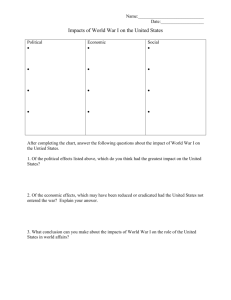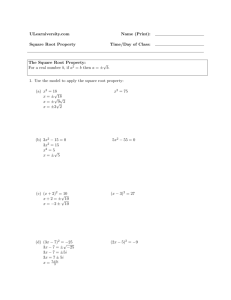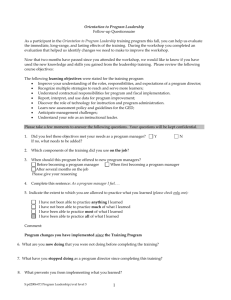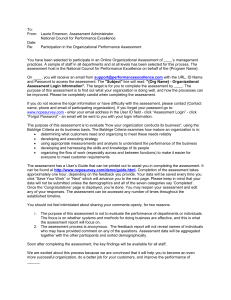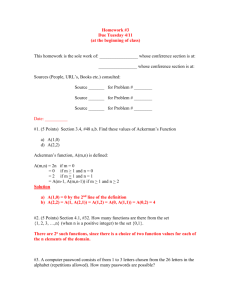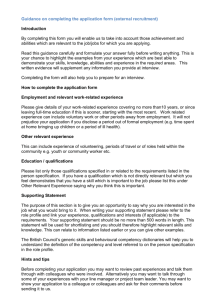Financial Records Organizer
advertisement
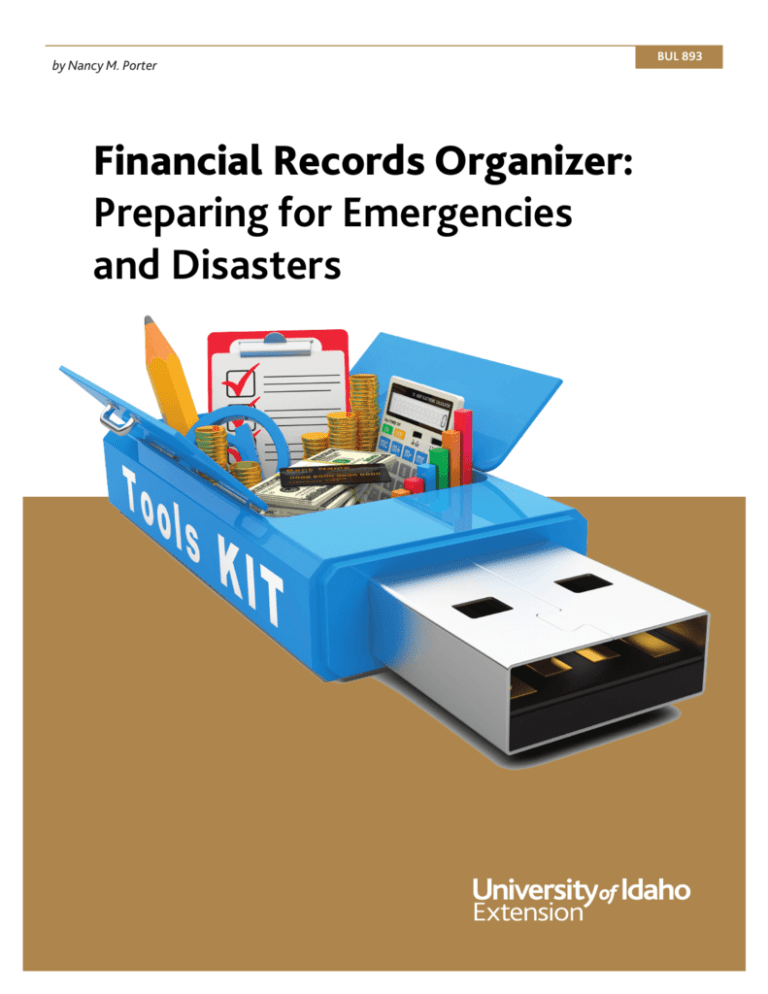
by Nancy M. Porter Financial Records Organizer: Preparing for Emergencies and Disasters BUL 893 Contents Importance of Taking Action Now...................................... 3 Tax Records............................................................................. 3 Records of Significant Purchases........................................ 3 Using the Organizer.............................................................. 4 Protecting Sensitive Financial Information....................... 4 Portable Fireproof Box—Your Emergency Kit................... 4 Forms....................................................................................... 5 1. Family members.......................................................... 6 2. Location of important papers................................... 7 3. Assets A. Financial accounts (checking with debit cards, money management accounts) and safe deposit box................................................... 12 B. Savings accounts and certificates of deposit.13 C. Real estate............................................................ 14 D. Real estate you lease/rent................................. 15 E. Stocks.................................................................... 16 F. Bonds, notes, bills................................................ 17 G. Mutual funds and exchange traded funds (EFTs) not held in retirement accounts........... 18 H. Other investments (annuities, IRAs)............... 19 I. Retirement benefits............................................20 J. Personal property (autos, jewelry, guns, collections, etc.).................................................. 21 K. Notes, mortgages owed to you, and accounts receivable.............................................22 L. Trusts.....................................................................23 4. Liabilities A. Mortgages and other real estate debt.............24 B. Liens against personal or business property (e.g., vehicle or machinery loans).....................25 C. Real estate leased/rented by you from a different landowner............................................26 D. Other personal liabilities (credit cards, loans, money owed to others).......................... 27 5.Insurance A. Life insurance policies.........................................28 B. Other insurance policies (auto, disability, health, homeowner’s, long-term care, renter’s, umbrella)...............................................29 6. Miscellaneous financial information.....................30 7. Professional advisors, guardian(s), personal representative(s), doctor(s), and dentist(s).........32 8. Account passwords...................................................35 Acknowledgment—This publication was adapted from Colorado State University Extension fact sheet #9.156, (http://www.ext. colostate.edu/pubs/consumer/09156.html) 06/2011 The author—Nancy M. Porter is Personal and Family Finance Consultant with University of Idaho Extension. Issued in furtherance of cooperative extension work in agriculture and home economics, Acts of May 8 and June 30, 1914, in cooperation with the U.S. Department of Agriculture, Barbara Petty, Interim Director of University of Idaho Extension, University of Idaho, Moscow, Idaho 83844. The University of Idaho provides equal opportunity in education and employment on the basis of race, color, national origin, religion, sex, sexual orientation, age, disability, or status as a disabled veteran or Vietnam-era veteran, as required by state and federal laws. Published May 2015 © 2015 by the University of Idaho attorney and giving a trusted person access to your financial accounts so they can handle business for you in a timely manner. This way you avoid having to cut your trip short. Importance of Taking Action Now Life’s emergencies require advance preparation and planning. The first step is organizing your financial information. Do you have an appropriate place for filing each document? Have you told anyone where you keep your vital information? Have you shared your wishes in the event of your death? Are your documents available to “grab and go” in case of an evacuation? Many situations require that you take action now to avoid financial problems later. Tax Records Your spouse and adult children—and any others who would need to handle your financial affairs—should know the location of all papers, contracts, documents, policies, and other needed information. Each should also know to whom to turn for advice in case of emergency. This publication provides advice for safeguarding your important documents and a set of fillable forms for recording your personal and financial information, identifying your advisors, and giving the locations of important documents. The Internal Revenue Service has three years to audit federal income tax returns (or two years from the date the tax was paid, whichever is later). However, this limit does not apply in “unusual” cases. If an amount of income which should have been reported was not, and it is more than 25 percent of the income shown on the return, the period of limitation does not expire until six years after the return was filed. The timeline for keeping records of capital assets is the holding period plus six years. Natural disasters—Wherever you live, there is always the risk of fires, floods, and other disasters. Your home and important documents could be totally destroyed. Prepare yourself so you can minimize the impact. Insurance policies and purchase receipts should be systematically filed for easy access if an insurance claim is necessary. For the best protection, keep the originals in a safe place and file copies elsewhere. 3 Organizing your tax records makes tax preparation much easier. It is also essential in preparing for an audit or before consulting with an accountant to explore possibilities for lowering your taxes in future years. Tax files should include federal and state income tax returns, all forms, and supporting documents—such as W-2 forms; 1099 forms; bank statements; cancelled checks; credit card receipts and statements; records of capital assets, gains, and losses; and all other receipts for tax-deductible items (interest paid, child and medical care, donations, business expenses, real estate and personal property taxes, and casualty losses). There is no time limitation when a return is false or fraudulent, or when no return was filed (see IRS Publication 552, Recordkeeping for Individuals). While you do not have to keep all possible financial records for tax purposes, if audited you will want to have cancelled checks or other verification of payment relating directly to entries on your tax return. In some cases, it is advantageous to keep records longer than the recommended period. For example, if you are selling your principal residence and claiming the capital gains exclusion allowed by the IRS, documentation of the original purchase price and capital improvements may be required. Theft—Theft can occur in an instant. Your wallet could be stolen from your office or your camera from your vehicle. Do you have a list of credit and debit card numbers, copies of recent statements, and company contact information? This is necessary so you can quickly report stolen cards before they are used unlawfully. For easy access to this important information, photocopy the front and back of each credit and debit card. Do you have a recent property inventory completed with serial numbers to help in getting stolen property returned? Sudden illness or death—Contingency plans also may be needed for sudden injury, illness, or death. If you were incapacitated, who would handle your affairs and how would that person gain access to your important documents? Would they have a durable power of attorney to act on your behalf? Would someone have access to your dental or medical records in order to provide positive identification of your remains? By making these plans ahead of time, you ease the stress your loved ones would face. Records of Significant Purchases Ideally, you should keep a record of all significant purchases (big ticket items) and property you own. Keep all “paid in full” statements for life, in case there is ever a question about payments. A good way to keep records is to video or take photos of each item as you buy it. With video on a smart phone or camera, you can speak about what the item is, the purchase date, how much you paid for it, whether there is an extended warranty, what it is worth, and give documentation of appraisal. This way you have an excellent record for Contingency plans—And what if while traveling you discover that a financial account needs attention? Prepare for your trip by creating a durable power of 3 insurance purposes and you increase your chances of recovering costs of lost, stolen, or damaged property. If the property is damaged or destroyed, you can also take photos or video to show the extent of the damage in comparison to the originals. It is very important to encrypt the sensitive data stored on your computer and on mobile storage devices such as external disks and USB flash drives. Mobile storage devices can carry a lot of information. Be sure that they are always secured and do not get lost or misplaced. Creating strong passwords—Security of electronic Using the Organizer files requires the user to authenticate (use a password) when accessing the information. Password protection requires using strong passwords. Key aspects of strong passwords include length (6 to 14 characters); a mix of letters (uppercase and lowercase), numbers, and symbols; no references to your personal information; and no dictionary words (English or foreign). You should change your passwords regularly (every 45 to 90 days) and never keep your passwords written down near your computer or mobile storage devices. Use the forms that follow to organize your information in one place. First save this publication file to your computer, external disk, or USB flash drive with a name you will easily remember. To fill in the forms, just click in each box and type your information. If you need additional space, duplicate the file. Fill in the forms as completely as possible and update them as your situation changes. These electronic forms are easy to keep up-to-date. As your situation changes, just delete the information in a box and type in the new information. If you prefer, you can print a copy of the forms and write the information in each box. If you use a pencil, you can erase and add new information as necessary. Portable Fireproof Box—Your Emergency Kit Complete the forms with your spouse and others who need access to your personal information. If spouses have separate financial accounts, liabilities, etc., they can complete separate forms. If your attorney has your will, provide copies of the completed forms to be placed in your file so your personal representative has access to both. Give other copies of the forms to your close relatives or trusted individuals who have copies of your important documents. Keep copies of documents such as wills and trust agreements in a portable fireproof box for easy access. • Adoption papers • Bank statements and brokerage statements for past year • Birth certificates for household members • Blank checks from each checking account • Credit/debit/ATM cards (color copies, both sides) When the forms are completed and kept up-to-date, you or others who might have to manage your affairs will know where to find all records. (It is important to be specific when listing the location of items.) They will also know how to contact your advisors, such as a lawyer, accountant, primary doctor, or dentist. The forms can be used to create an effective filing system to manage your vital information. • Deed to your residence • Documents that prove ownership of investments • Driver’s licenses (color copies) • Health insurance, prescription, and/or other benefit cards (color copies) • Identification cards issued by your banks • Insurance policies and agent/agency contact information Protecting Sensitive Financial Information • Inventory of household and personal items; photographic documentation for inventory of household and home office items (keep additional copies at a work office or another location) Store your information on an external disk, USB flash drive, or other device for portability in case of evacuation along with computer scans of original documents and family photos. Keep hard copies of the forms and files in a safe place known to your family and/ or advisors. Protect this information from access by unauthorized people. • List of assets and liabilities, with details of ownership and the contact information for all persons and entities relevant to the ongoing status of that asset or liability 4 4 If you don’t already have a portable fireproof box, consider getting one. It should be large enough to hold files and a few valuables, but not so large that you can’t easily carry it out if you have to evacuate. Keep your external disk, USB flash drive, or a copy of your completed forms in this emergency kit. Here are some other suggested items for your kit: • List of contact information for advisors, personal representatives, trustees, guardians, doctors, dentists Forms • List of electronic access user IDs, passwords, PINs, and digital assets. (Digital assets consist of personal information that is stored electronically on either your personal computer or an online “cloud” server. Anyone who uses e-mail, has a password-protected cell phone, makes online purchases, pays bills online, or has social media accounts has digital assets.) 2. Location of important papers 1. Family members 3. Assets A. Financial accounts and safe deposit box B. Savings accounts and certificates of deposit C. Real estate D. Real estate you lease/rent • Location of safe-deposit boxes (with key location) and names of authorized signatories E.Stocks • Marriage certificate, marriage license, divorce documents G. Mutual funds and exchange-traded funds not held in retirement accounts • Military service records H. Other investments • Mortgage documents and other loan documents I. Retirement benefits • Passports (color copies) J. Personal property • Religious certificates K. Notes, mortgages owed to you, and accounts receivable F. Bonds, notes, bills • Retirement plans (e.g., pension documents, summary plan descriptions) L.Trusts • Social Security cards for household members 4. Liabilities • Tax returns for a minimum of three years A. Mortgages and other real estate debt • Titles for vehicles B. Liens against personal or business property • Trusts for which you are a trustee or in which you have a beneficial interest C. Real estate leased/rented by you from a different landowner • Wills, living wills, power of attorney, durable power of attorney for health care, and letters of last instruction D. Other personal liabilities 5. Insurance A. Life insurance policies As you can see, much of the information on this list is already called for elsewhere on the forms. Keeping track of your vital information should be made as simple as possible. Don’t make it any harder than it has to be. B. Other insurance policies 6. Miscellaneous financial information 7. Professional advisors, guardian(s), personal representative(s), doctor(s), and dentist(s) 8. Account passwords YOU are responsible for protecting your financial information. The information in your emergency kit and on these forms should be carefully secured and protected against unauthorized access. Using strong passwords on all your disks, USB flash drives, or other devices that contain sensitive financial information is very important. 5 1. Family members Name (first, middle initial, last) Relationship Date of birth Email Address Person completing this information: Date completed: _________________________________________________ __________________________ 6 Phone number Social Security number 2. Location of important papers Item Specific location Contact information Adoption papers Advance directives for health care Durable power of attorney for health care Living will Birth certificates Business/farm records Credit cards Death certificates Person completing this information: Date completed: _________________________________________________ __________________________ 7 location of important papers continued, next page 2. Location of important papers, cont. Item Specific location Contact information Estate-planning documents Will Beneficiary designations Cemetery plot deed Funeral preferences Letter of last instruction Power of attorney Trust documents Person completing this information: Date completed: _________________________________________________ __________________________ 8 location of important papers continued, next page 2. Location of important papers, cont. Item Specific location Contact information Divorce papers Education diplomas/certificates Employment records Financial records (bank, credit, debts) Health records/insurance cards Home improvement records Housing documents (mortgage, appraisals, deeds, surveys, inspections, pest control) Insurance policies Person completing this information: Date completed: _________________________________________________ __________________________ 9 location of important papers continued, next page 2. Location of important papers, cont. Item Specific location Contact information Leases Marriage license/certificate Memorial society membership Military records Naturalization documents Passports/green cards Personal property inventory Pet records Person completing this information: Date completed: _________________________________________________ __________________________ 10 location of important papers continued, next page 2. Location of important papers, cont. Item Specific location Religious records/certificates Rewards/loyalty program information Safe-deposit box Inventory of contents Number and keys Social Security cards Tax documentation (income, property) Warranties Person completing this information: Date completed: _________________________________________________ __________________________ 11 Contact information 3. Assets A. Financial accounts (checking with debit cards, money management accounts) and safe-deposit box Financial institution address Type of account Exact name(s) on account Account, card, PIN, or box number Person completing this information: Date completed: _________________________________________________ __________________________ 12 Amount POD (Payable on death) assets continued, next page 3. Assets, cont. B. Savings accounts and certificates of deposit Financial institution address Type of account Exact name(s) on account Person completing this information: Date completed: _________________________________________________ __________________________ 13 Account number Amount Maturity date assets continued, next page 3. Assets, cont. C. Real estate Legal description of property Title holder (you, spouse, joint) Exact names on title Person completing this information: Date completed: _________________________________________________ __________________________ 14 Year acquired Cost Market value and date assets continued, next page 3. Assets, cont. D. Real estate you lease/rent Legal description of property Lessee name Contact information Lease type Person completing this information: Date completed: _________________________________________________ __________________________ 15 Lease/rental rate Duration of lease Rent due (month/ year) assets continued, next page 3. Assets, cont. E. Stocks Company/description Contact information Name on certificate(s) Purchase price/date Number of shares Person completing this information: Date completed: _________________________________________________ __________________________ 16 Certificate numbers Location of certificates assets continued, next page 3. Assets, cont. F. Bonds, notes, bills Issuer/bond number Contact information Face amount Bond holder Purchase price/ date Person completing this information: Date completed: _________________________________________________ __________________________ 17 Maturity date Location of certificates assets continued, next page 3. Assets, cont. G. Mutual funds and exchange traded funds (ETFs) not held in retirement accounts Company/description Contact information Name(s) on account Person completing this information: Date completed: _________________________________________________ __________________________ 18 Purchase price/date Number of shares Current value TOD (transfer on death) assets continued, next page 3. Assets, cont. H. Other investments (annuities, IRAs) Company/description Contact information Owner (you, spouse, joint) Type Person completing this information: Date completed: _________________________________________________ __________________________ 19 Beneficiary Amount Distribution method assets continued, next page 3. Assets, cont. I. Retirement benefits Company/description Contact information Owner (you, spouse, joint) Type of plan (401(k), 403(b), 457) Person completing this information: Date completed: _________________________________________________ __________________________ 20 Beneficiary Amount Distribution method (annuity, lump sum) assets continued, next page 3. Assets, cont. J. Personal property (autos, jewelry, guns, collections, etc.) Description Owner or title holder (you, spouse, joint) Location of title, if any Person completing this information: Date completed: _________________________________________________ __________________________ 21 Cost Market value assets continued, next page 3. Assets, cont. K. Notes, mortgages owed to you, and accounts receivable Description Name of person who owes you Year acquired Person completing this information: Date completed: _________________________________________________ __________________________ 22 Value Other assets continued, next page 3. Assets, cont. L. Trusts Type Trustee Contact information Person who created trust and date Person completing this information: Date completed: _________________________________________________ __________________________ 23 Beneficiary Value of trust property 4. Liabilities A. Mortgages and other real estate debt Description Name of creditor and contact information Account number Amount of payment/due date Person completing this information: Date completed: _________________________________________________ __________________________ 24 Balance due by name(s) on loan If insured, by whom liabilities continued, next page 4. Liabilities, cont. B. Liens against personal or business property (e.g., vehicle or machinery loans) Description Name of creditor and contact information Account number Amount of payment/due date Person completing this information: Date completed: _________________________________________________ __________________________ 25 Balance due by name(s) on loan If insured, by whom liabilities continued, next page 4. Liabilities, cont. C. Real estate leased/rented by you from a different landowner Type of property and acres Landowner’s name Contact information Lease type (cash, share, etc.) Person completing this information: Date completed: _________________________________________________ __________________________ 26 Lease/rental rate Rent due (month/year) liabilities continued, next page 4. Liabilities, cont. D. Other personal liabilities (credit cards, loans, money owed to others) Name of creditor Account number Date due Balance Person completing this information: Date completed: _________________________________________________ __________________________ 27 Name(s) on account If insured, by whom 5. Insurance A. Life insurance policies Company and contact information Owner (you, spouse, or joint) Person insured Beneficiary Type of policy/face amount/maturity date Person completing this information: Date completed: _________________________________________________ __________________________ 28 Policy number Cash value and any outstanding loan insurance continued, next page 5. Insurance, cont. B. Other insurance policies (auto, disability, health, homeowner’s, long-term care, renter’s, umbrella) Company and contact information Type of insurance Policy number Deductible Person completing this information: Date completed: _________________________________________________ __________________________ 29 Coverage Renewal date 6. Miscellaneous financial information Income source Name Amount Contact/benefits information Wages - Employer 1 Wages - Employer 2 Wages - Employer 3 Alimony Business/farm Child support Custom work Mineral rights Person completing this information: Date completed: _________________________________________________ __________________________ 30 miscellaneous financial information continued, next page 6. Miscellaneous financial information, cont. Income source Name Amount Contact/benefits information Pension Public benefits (SSI, unemployment insurance) Social Security Structured settlements Veteran’s income Other Person completing this information: Date completed: _________________________________________________ __________________________ 31 7. Professional advisors, guardian(s), personal representative(s), doctor(s), and dentist(s) Advisor type Name Phone Email Address Accountant/tax preparer Attorney Banker Clergy Dentist(s) Doctor(s) Specialists Employer human resources Person completing this information: Date completed: _________________________________________________ __________________________ 32 professional advisors continued, next page 7. Professional advisors, guardian(s), personal representative(s), doctor(s), and dentist(s), cont. Advisor type Name Phone Email Address Financial planner Guardian(s) Insurance agent(s) Investment advisor(s) Personal representative(s) Powers of attorney Durable power of attorney for health care Durable power of attorney Person completing this information: Date completed: _________________________________________________ __________________________ 33 professional advisors continued, next page 7. Professional advisors, guardian(s), personal representative(s), doctor(s), and dentist(s), cont. Advisor type Name Phone Email Trustee Others Person completing this information: Date completed: _________________________________________________ __________________________ 34 Address 8. Account passwords* Company/organization Username Strong password** Last date changed Web URL * Do not forget to include passwords for digital assets, personal information that is stored electronically on either a personal computer or an online “cloud” server. Anyone who uses e-mail, has a password protected cell phone, makes online purchases, pays bills online, or has social media accounts has digital assets. **Using strong passwords on electronic files containing financial information is very important. Microsoft provides a Password Checker website (https://www.microsoft.com/en-gb/security/pc-security/password-checker.aspx) to help determine if a password is strong. To achieve maximum strength, the Password Checker requires a password to have at least 14 characters containing at least one of each of the following types of characters: an uppercase letter, a lowercase letter, a number, and a special character. As added security, most experts also recommend that passwords not contain your username, real name, company name, or complete words; that each password be unique; and that all passwords be significantly different from previous passwords. account passwords continued, next page 35 8. Account passwords, cont. Company/organization Username Strong password Last date changed Web URL account passwords continued, next page 36 8. Account passwords, cont. Company/organization Username Strong password Last date changed Web URL account passwords continued, next page 37 8. Account passwords, cont. Company/organization Username Strong password 38 Last date changed Web URL
